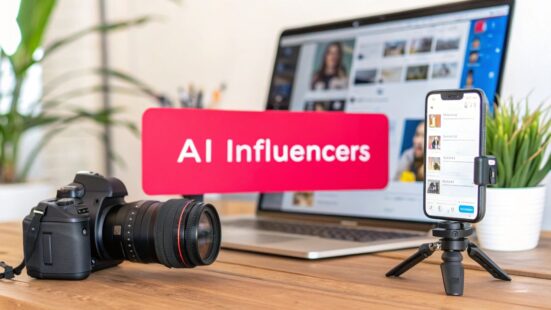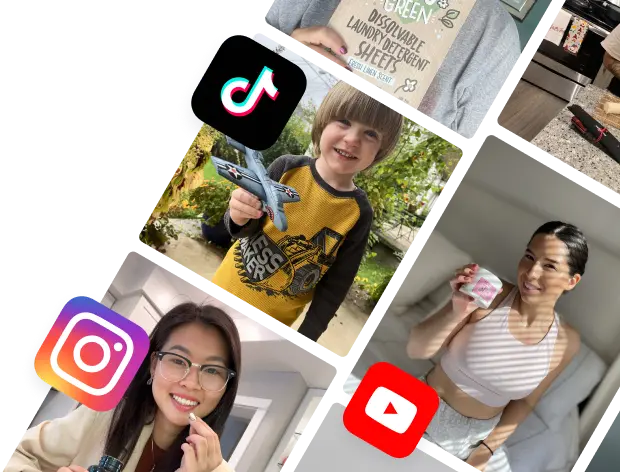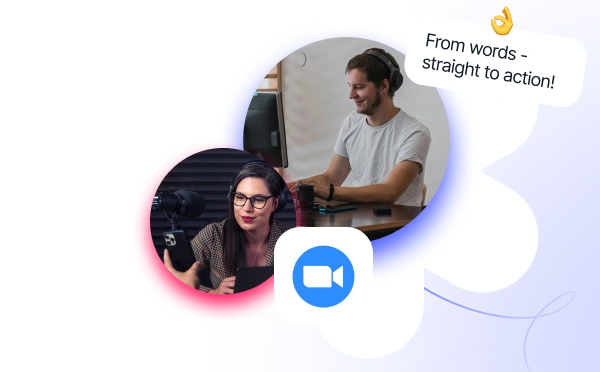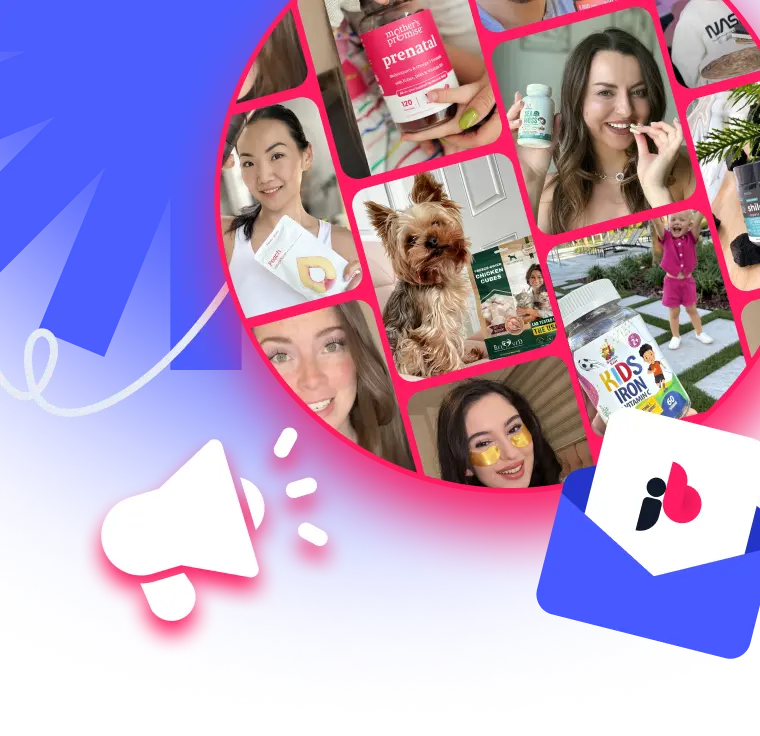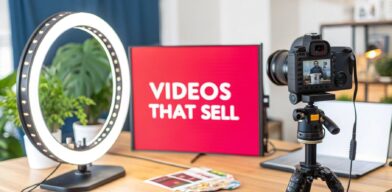 How to Create Product Videos That Sell
How to Create Product Videos That Sell
You've probably seen them popping up on your social media feeds. Characters that look almost human, partner with huge brands, and have millions of followers. But here’s the twist: they aren’t real people.
An AI-generated influencer is a fully digital character brought to life with artificial intelligence and computer-generated imagery (CGI). Don't think of them as clunky robots. Instead, picture them as virtual actors, each with a unique personality, a detailed backstory, and a carefully curated social media presence built to connect with online communities and promote products.
Table of Contents
Decoding the AI-Generated Influencer
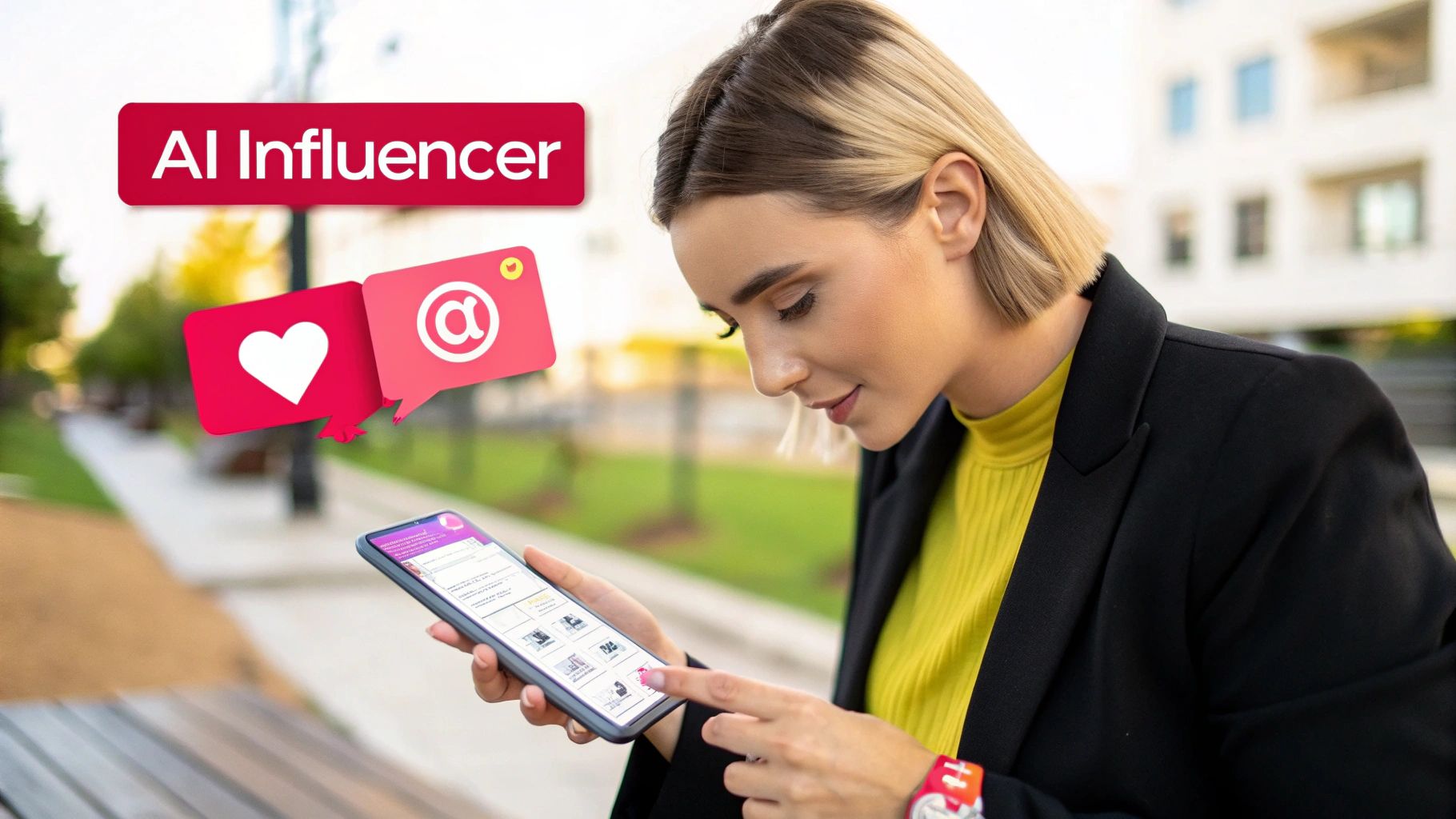
Let's be clear: an AI-generated influencer is so much more than a digital puppet. They are meticulously crafted virtual personas, born from a potent mix of creative storytelling and sophisticated technology. They aren't born; they're built, piece by piece, by teams of designers, writers, and AI specialists.
Imagine a brand needs a new face for its next big campaign. Instead of scrolling through headshots, they can literally design one from scratch. This digital character gets a name, a complete backstory, a distinct personality, and a specific look. They're not just models; they are fully-formed characters engineered to resonate with a very specific audience on a much deeper level.
The Building Blocks of a Virtual Persona
Creating a believable AI influencer isn't magic. It's a careful process where art and data science come together to make sure the final creation is both engaging and effective.
- Visual Creation: This is where the influencer gets their look. Using high-end CGI and 3D modeling tools, artists craft everything—from facial features and fashion sense to their posture and expressions—to make them appear lifelike and relatable.
- Personality and Backstory: A dedicated creative team writes their life story. This includes their hobbies, values, friends, and even their struggles. This rich narrative makes their social media feed feel authentic and gives followers a reason to form a genuine connection.
- AI-Powered Interaction: Behind the scenes, artificial intelligence is the engine that runs their social media. AI can analyze audience sentiment, generate content ideas, and even help craft replies to comments, allowing the "influencer" to engage with thousands of followers at a scale no human could manage.
A key takeaway is that these virtual influencers are not just automated bots. They are strategic assets, combining human creativity for their core identity with AI for operational efficiency and audience engagement.
Pioneers in the Digital Space
The idea of a virtual influencer isn't brand new, but its recent explosion in popularity is impossible to ignore. Conversations online about AI influencers have skyrocketed, with over 114,000 mentions in the first five months of 2025 alone—that's a 50% jump from the previous year. This boom is all thanks to better algorithms and AI tech that make these characters more believable than ever.
Pioneers like Lil Miquela, who first appeared on Instagram back in 2016, and Shudu, the world's first digital supermodel, proved that audiences were more than ready to follow and engage with virtual personalities. You can dive deeper into this trend and see more consumer data over on Meltwater's blog.
So, Why Are Virtual Influencers Suddenly Everywhere?
If you’ve noticed a new kind of face popping up on your social media feeds, you’re not imagining things. The rise of the AI-generated influencer isn't some random fluke. It’s a smart response to some big shifts in how brands have to operate and what customers are looking for.
Companies are always on the hunt for more dependable, predictable, and scalable ways to reach people. Let's be honest, working with human influencers can sometimes be a headache. Virtual personas offer a pretty compelling answer to those challenges. This isn't just a quirky trend; it's a strategic move.
The real magic is in the blend of total control and genuine engagement. For a brand, an AI influencer is the perfect brand ambassador. They’ll never go off-script, get caught up in a messy public scandal, or just have a bad day. Every single post and message can be crafted to perfectly match the brand’s identity, which cuts out a ton of risk and keeps the public image clean and consistent.
The Engine Behind the Growth
This desire for control is hitting at the perfect time. The whole influencer marketing world is exploding—valued at $23.6 billion in May 2025, it’s expected to shoot up to nearly $71 billion by 2032. Inside this massive growth, AI influencers are carving out their own space, especially in visual-heavy fields like fashion and lifestyle. If you want to dive deeper into this growth, check out the latest Shopify findings.
But what really makes this trend stick is the data. On average, virtual influencers pull in engagement rates about 1.48% higher than their human peers. That might not sound like a huge number, but it's a game-changer in a market where 74% of consumers say they buy things based on what influencers recommend. A little more engagement can mean a lot more impact on sales.
The rise of virtual personas isn't just about cool new tech. It's about getting results. Brands are jumping on board because it's a data-backed way to grab attention and get people to act in a very noisy online world.
This all plugs into a bigger change in how we think about "authenticity." Younger audiences, especially, have grown up online. They're totally comfortable connecting with characters, whether it's someone from a video game, a movie, or a social media feed.
For this generation, authenticity isn't about whether someone is human or not. It’s about a consistent personality, a great story, and someone they can rely on for interesting content. An AI influencer that is upfront about what it is and consistently delivers fun, on-brand posts can build a loyal following just as well as any human creator.
Key Advantages of Using AI Influencers
At first glance, AI influencers might seem like a gimmick, but the strategic reasons for bringing one on board are surprisingly practical. For any brand, the biggest win is gaining absolute creative control. Think about it: every post, every caption, and every visual is crafted to perfectly match your brand’s voice and values. This completely sidesteps the unpredictability that can sometimes come with human collaborations.
That level of control also creates a powerful safety net for your brand. Human influencers are, well, human. Despite their best intentions, they can get caught up in personal controversies or post something off-brand that spirals into a PR headache. An AI influencer, on the other hand, is a closed system. They’ll never post something inappropriate, get mixed up in a scandal, or have a messy personal history that could tarnish your brand's image.
This visual breaks down how these benefits really shore up a brand's marketing.
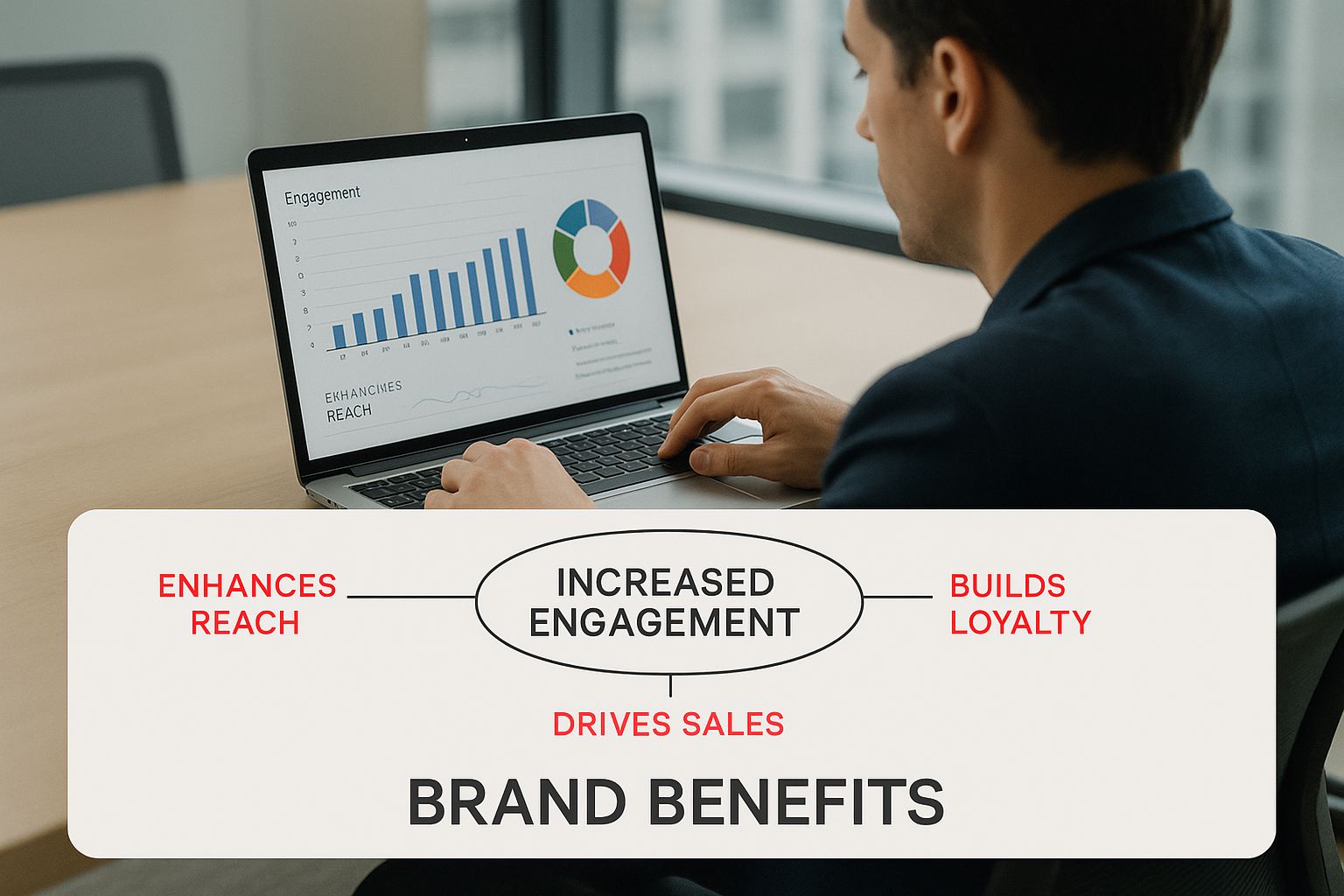
It’s clear that control, safety, and availability aren't just buzzwords—they are the core pillars for building a brand presence you can actually rely on and scale.
Unlocking Unmatched Flexibility
Another massive advantage is 24/7 global availability. An AI-generated influencer isn’t tied down by time zones, sleep, or travel schedules. They can be engaging with your audience in Tokyo, New York, and Paris all at the same time, pushing out tailored content around the clock. This kind of scalability lets you maintain a constant, active presence in multiple markets without the eye-watering costs and logistical nightmare of a global human team.
Imagine you’re launching a limited-time product. A virtual influencer can blast out the announcement across every social platform the second it goes live in each region, guaranteeing a synchronized message and maximum impact.
A Strategic Comparison
To really get a feel for the day-to-day differences, it helps to see the two approaches side-by-side. While human influencers bring a personal touch that’s hard to replicate, AI personas offer some serious operational perks that are tough to ignore.
Let's break down how they stack up.
Human Influencers vs AI Generated Influencers
| Feature | Human Influencer | AI Generated Influencer |
|---|---|---|
| Content Approval | Requires a lot of back-and-forth; potential for creative clashes. | Content is made in-house, guaranteeing 100% brand alignment from the start. |
| Risk Management | Vulnerable to personal scandals, old controversies, or going off-script. | Zero risk of personal drama or unpredictable behavior. |
| Scheduling | Limited by their availability, time zone, and personal life. | Operates 24/7/365 and can be deployed instantly for timely campaigns. |
| Long-Term Costs | Involves recurring fees, travel expenses, and potential rate hikes over time. | Higher initial setup cost, but much lower ongoing operational expenses. |
Ultimately, the choice between human and AI influencers depends on a brand's specific goals. Human influencers offer genuine, relatable connections, while AI influencers provide unparalleled control and efficiency.
Partnering with an AI influencer is less like hiring a contractor and more like building a valuable, long-term brand asset. It’s a shift from renting influence to owning a custom-built communication channel that you can shape, scale, and perfect over time.
This ownership model is a game-changer. It gives you the power to create a persona that grows with your brand. As you expand into new markets, your AI ambassador can be updated to speak new languages, reflect different cultural norms, and promote new products—all while keeping the core identity you built from day one.
Of course. Here is the rewritten section, designed to sound completely human-written, following all the specified requirements.
How Brands Succeed with AI Influencers
It’s one thing to talk about the potential benefits of an AI influencer, but it's another thing entirely to see one drive real results in the wild. This is where the rubber meets the road. Success isn't just about slapping a digital face on your brand; it’s about smart, strategic integration.
The brands that are absolutely crushing it with AI influencers aren’t using them as a one-off gimmick. Instead, they’re weaving them into the very fabric of their marketing to hit specific, measurable goals. From creating a viral tidal wave to building a loyal community, the ways they’re being used are as diverse as they are effective.
These forward-thinking brands get it: a virtual persona’s biggest advantage is its malleability. You can mold it perfectly to fit a campaign's core objective, allowing for a level of creative control and brand alignment that's often a headache to achieve with human talent alone.
Creating Viral Moments
For brands in the fast-fashion or youth-focused space, the name of the game is stopping the scroll. You need visually arresting content that makes people pause, and this is where an AI generated influencer truly shines. They open the door to campaigns that would be a logistical nightmare or just flat-out too expensive with human models.
Take a brand like Bershka, for example. They use their AI personas on high-energy platforms like TikTok to create surreal, can’t-look-away fashion campaigns. These digital characters can be dropped into fantastical, impossible worlds or wear digitally-rendered outfits that defy gravity. The result? Massive engagement that cements Bershka’s reputation as a trendsetter. The point isn’t just to display clothes; it's to create an unforgettable visual trip that gets people talking and hitting that share button.
These campaigns are proof in the pudding: when you get creative, an AI influencer can be an incredible asset for cutting through the noise in a crowded market and sparking brand conversation at a massive scale.
Building Long-Term Community and Sales
But it's not all about short-term buzz. An AI generated influencer can also be a long-term asset that cultivates a real community and, yes, directly drives sales. The gold standard here is Lu do Magalu, the virtual face of Brazilian retail giant Magazine Luiza. Lu is far more than a digital billboard; she's a core part of the customer journey.
She's been active for years, building a colossal following by posting product reviews, unboxing videos, and genuinely helpful tips. That consistent, long-term presence has built a foundation of trust and familiarity that cashes in at the checkout. Lu is the perfect blueprint for the long-game strategy:
- Consistent Engagement: She’s there every day, interacting with her audience and serving as a reliable source of information and fun.
- Brand Personification: She puts a friendly, approachable face on a massive corporation, making it feel less like a faceless entity.
- Direct Sales Driver: Her content is a masterclass in blending engagement with e-commerce, often linking straight to product pages.
Lu do Magalu’s incredible, enduring success shows what’s possible when a brand treats its AI influencer not as a temporary campaign, but as a central piece of its identity.
Diving Into the Ethical and Strategic Hurdles
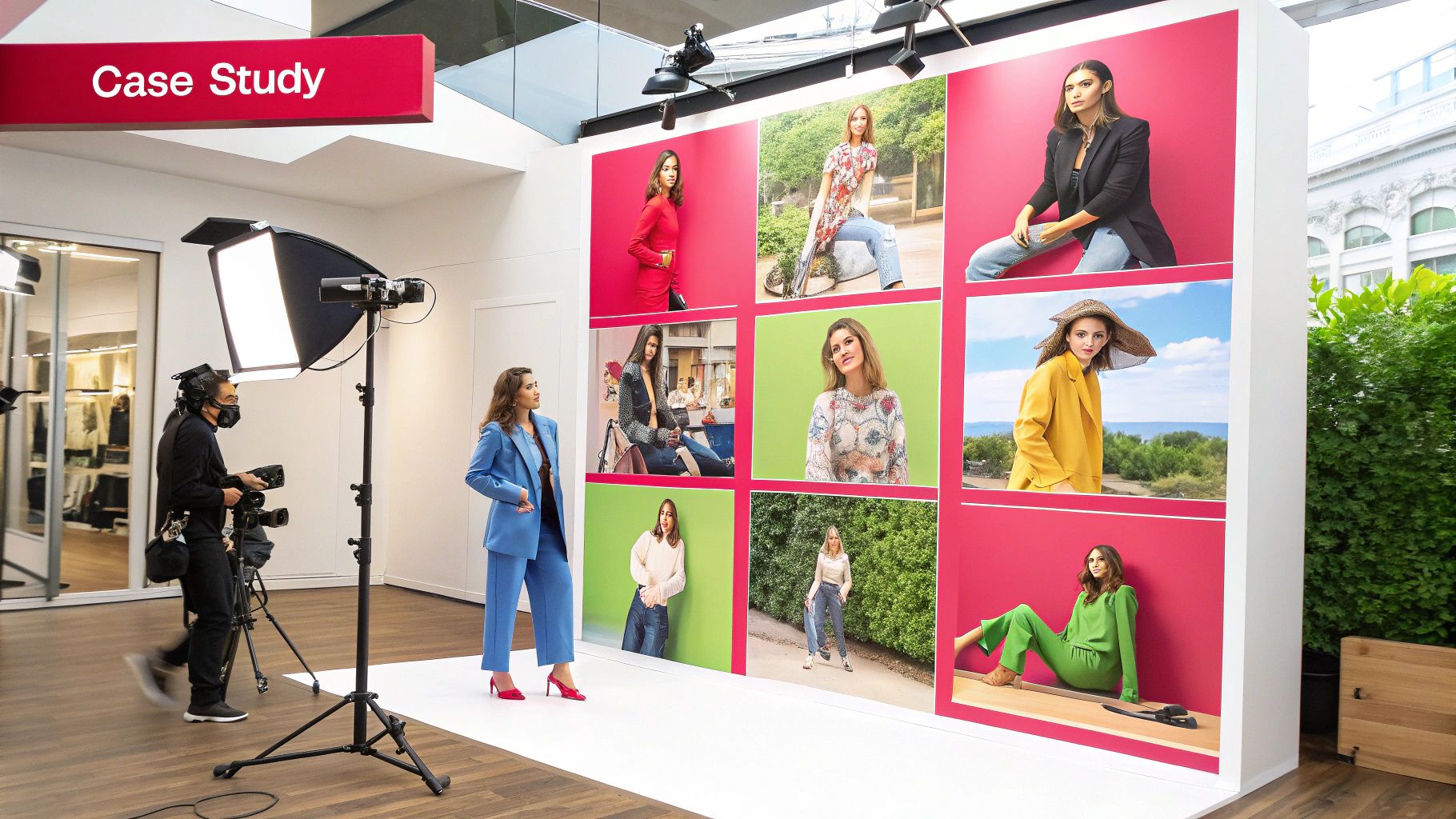
As cool as AI-generated influencers are, you can't just dive in without a game plan. There are a few significant hurdles to clear if you want your campaign to be a responsible success, not just a flashy experiment.
The biggest challenge by far is keeping your audience's trust. Authenticity is the name of the game online, and trying to pass off a digital creation as a real person can blow up in your face. Fast. People are smart—if they feel like you've tried to trick them, the hit to your brand's reputation will be swift and painful.
This is exactly why transparency is non-negotiable.
The Transparency Rule
Building trust starts with being upfront about who—or what—your influencer is. Trying to hide the fact that your ambassador is an AI construct isn't a strategy; it's a gimmick with a very short shelf life. Brands that are really nailing this embrace the virtual nature of their influencer and make it part of the story.
It boils down to a simple rule: never, ever mislead your audience. You have to use clear disclosures. Something as simple as the hashtag #AIinfluencer or a quick note in the bio does the trick. This honesty doesn't kill the magic; for a lot of people, it actually makes it more interesting.
When you're transparent, you completely change the conversation. It's no longer about "Is this person real?" but "Wow, what a cool creative project!" This builds a much healthier and more engaged community around your digital persona—one based on honesty, not illusion.
The Bigger Picture: Broader Ethical Questions
Beyond just being honest, there are some wider ethical questions you need to wrestle with. A good strategy means thinking about the potential ripple effects on the creator economy and even society as a whole.
- Impact on Human Creators: Is the rise of AI influencers taking jobs away from real people? It's a valid concern. While AI offers incredible control, it can't replicate a real human story or experience. Brands should view AI influencers as just another tool in the marketing toolbox, not a wholesale replacement for the unique, powerful voices of human creators.
- Perpetuating Unrealistic Standards: It's tempting to design an AI influencer to be "perfect" in every way. But this comes with a serious risk of feeding into unrealistic beauty or lifestyle standards. The responsible move is to create characters with relatable, diverse, and maybe even flawed personalities. This ensures your creation isn't just adding to the negative social pressures already out there.
At the end of the day, launching a successful AI influencer is all about striking a thoughtful balance. If you put transparency first and think through the social impact, you can create a digital ambassador that's both a powerhouse marketing asset and a positive presence online. That kind of foresight is what responsible innovation is all about.
The Technology That Brings Influencers to Life
An AI-generated influencer is so much more than just a pretty digital face. It’s easy to get caught up in the advanced CGI and 3D modeling that creates how they look, but the real magic happens behind the scenes with some seriously sophisticated artificial intelligence. This tech is the engine that drives everything from their personality to their content, turning them from digital puppets into truly intelligent marketing assets.
Think of it this way: if CGI is the artist who paints the portrait, AI is the brain that actually gives the character a life of its own. This is way beyond simple automation. We’re talking about deep personalization and content optimization, which allows these virtual personas to connect with real audiences on a surprisingly personal level.
From Data to Deep Connection
The real game-changer here is how AI digs into audience behavior. It blows past basic demographics like age and location and gets into what we call psychographic profiling. In plain English, this means the AI can understand an audience's values, interests, and even emotional triggers. This allows a brand to create an influencer who genuinely clicks with a specific niche.
It’s a hyper-targeted approach that’s already reshaping the industry.
Looking ahead, 2025 trends show that AI-powered personalization is the number one strategy in this space, making up 35.2% of all AI-driven influencer activities. Right behind it is AI for content creation, which accounts for another 24.8% by automating tasks from scriptwriting to video editing.
This one-two punch of deep personalization and automated content lets a single AI-generated influencer pump out tons of quality content that feels personally relevant to every follower. That’s a scale human teams just can’t match.
But AI doesn't work in a vacuum. The technology also extends to creating the immersive worlds these influencers live in. While AI handles the operational smarts, it still takes a ton of human talent to build the virtual characters and their environments. To really get a feel for the expertise involved, it’s worth understanding the roles of XR designers, who are the architects of these believable digital realities.
Ultimately, the tech behind an AI influencer is a powerful mix of data science, creative automation, and pure human artistry.
Of course. Here is the rewritten section, crafted to sound human-written, natural, and expert-driven, following the provided style guide.
Let's Talk About AI Influencers (Your Questions, Answered)
As this technology gets more popular, it's completely normal for questions—and maybe a little bit of healthy skepticism—to pop up. Getting straight answers helps clear the fog, separating the real-world possibilities from all the sci-fi hype so you can navigate this new space with confidence.
So, let's dive into some of the most common questions marketers have when they start thinking about bringing an AI influencer into their strategy.
How Much Does an AI Influencer Actually Cost?
The cost can swing wildly depending on the path you take. If you’re thinking about building a custom, super-realistic AI influencer completely from scratch, that’s a serious investment. You could easily be looking at thousands of dollars just for the initial development, not to mention the ongoing work to create content.
But there’s a much more accessible route. You can partner with a virtual influencer who already exists or use a platform that gives you pre-made or customizable options. This is almost always more cost-effective than hiring a top-tier human creator and comes with predictable rates—no surprise fees for travel or shipping products.
Can an AI Influencer Genuinely Feel Authentic?
Here's the thing: authenticity for an AI influencer isn't about pretending to be human. It’s all about being consistent and believable within their own world. Their authenticity comes from a well-defined personality, a story that people can get invested in, and behavior that makes sense for their character.
For the audience, authenticity is rooted in the character's reliability and entertainment value, much like a beloved fictional character in a film or novel. Transparency is also key—audiences engage more positively when they know they are interacting with a digital creation.
What Does the Future Look Like for AI Influencers?
The future is all about deeper immersion and genuine interaction. I think we can expect the next wave of AI influencers to hold real-time, personalized conversations with their followers, all powered by much smarter conversational AI.
They'll likely become go-to figures in the metaverse and VR spaces, acting as our virtual guides and brand ambassadors in these new digital worlds. As the tech gets easier to use, it will open the door for even smaller brands to create their own virtual personalities, making the AI-generated influencer a totally mainstream marketing tool.
Ready to harness the power of authentic content at scale? With JoinBrands, you can connect with over 250,000 creators, including AI and UGC producers, to amplify your social presence and accelerate sales. Start your campaign today!
